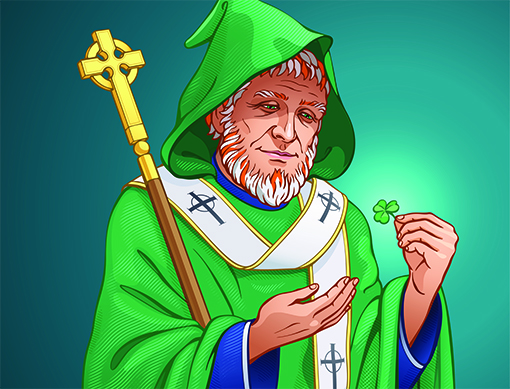St. Patrick is a saint who is both widely celebrated and not well-known. Though he is the patron saint of Ireland, he isn’t Irish. Though he was a bishop, he wasn’t always a believer. Though he served the people of Ireland, it wasn’t love at first sight.
 St. Patrick’s story is an interesting narrative of contradictions, and a wonderful example of how the road of life, filled with obstacles and what we think are wrong turns, can still lead to fulfilling your God-given purpose.
St. Patrick’s story is an interesting narrative of contradictions, and a wonderful example of how the road of life, filled with obstacles and what we think are wrong turns, can still lead to fulfilling your God-given purpose.
Patrick was born in Britain to a wealthy family. At the age of 16, he was captured by Irish pirates and taken back to Ireland where he spent six years in forced servitude tending sheep. He was not well-treated, struggled with loneliness, hunger and cold. In his, Confessio, Patrick admitted, “I did not then believe in the living God, not even when I was a child.”
In these difficult times, a young Patrick eventually turned to God. One night, in his dreams, he had a vision of a boat waiting on shore and a voice telling him it was time to go home. Patrick believed the voice to be God’s, so he escaped from his captivity and walked 200 miles to the coast of Ireland where he did find a boat heading back to Britain.
Once home, he again had dreams in which he heard voices calling to him. He understood them to be the voices of the Irish people calling to him to come back. Which he did, after years of preparing for the priesthood and eventually being ordained a bishop at age 43.
St. Patrick made great inroads with the Irish people, as he was totally focused on bringing the Gospel of Jesus to the people he had grown to love. Today he is the patron saint of Ireland, and his feast day, March 17, is celebrated worldwide, and with it the cultural heritage of the Irish people. It is also an optional memorial in the Catholic liturgical calendar.
Like so many holidays with a religious basis, St. Patrick’s Day has become secularized and commercialized in contemporary culture. A celebration of good times and good luck is filled with Images of leprechauns, rainbows and pots of gold, corned beef and cabbage dinners, reasons to indulge in frosty mugs of beer, and enjoyable, to be sure.
As educators we can ensure that students enjoy the celebration without losing the spiritual significance of St. Patrick.
Celebrating St. Patrick’s Day as a Catholic holiday:
Discuss the life of St. Patrick – Introduce students to the life of St. Patrick. According to their age, ask students questions they must answer with more than a yes or no. You might begin with “What surprised you about St. Patrick?” “Do you pray to God when you are alone or afraid?” “How did St. Patrick’s love of God make other people’s lives better?”
Teach about the Trinity – Tradition says that St. Patrick taught the Irish to understand three persons in one God by using shamrocks, a small clover-like plant with three leaves on one stem, to illustrate the Holy Trinity as three persons in one God. Like Jesus, who also used images and stories to teach, St. Patrick used the shamrock, now the national emblem of Ireland, to make the mystery of God accessible to the Irish people.
Include a lesson on the role of bishop – Check your curriculum texts for opportunities to discuss the role of bishops in the Church. Images of St. Patrick often portray him with a staff in one hand and shamrocks in the other. Include explanations of a bishop’s mitre, staff, coat of arms, all perfect subjects for an art class. Encourage students to create their own coat of arms, using images from religion classes – doves, flames, wheat, crowns, hearts, crosses or angel wings, as examples.
For teachers – Perhaps the best way to get to know St. Patrick is to read his touching and inspiring Confessio, written by him while in Ireland. We are introduced to St. Patrick as a humble man with unwavering trust in God, who shares many of his trials and tribulations while serving the Irish people. He closed his Confessio with these words:
“I pray for those who believe in and have reverence for God. Some of them may happen to inspect or come upon this writing which Patrick, a sinner without learning, wrote in Ireland. May none of them ever say that whatever little I did or made known to please God was done through ignorance. Instead, you can judge and believe in all truth that it was a gift of God. This is my confession before I die.”
 About the Author
About the AuthorMary Clifford Morrell, mother of six and grandmother to ten, is a Catholic journalist, editor, and author who has served the Dioceses of Metuchen and Trenton, New Jersey; Burlington, Vermont, and RENEW International in the areas of religious education and communication.
